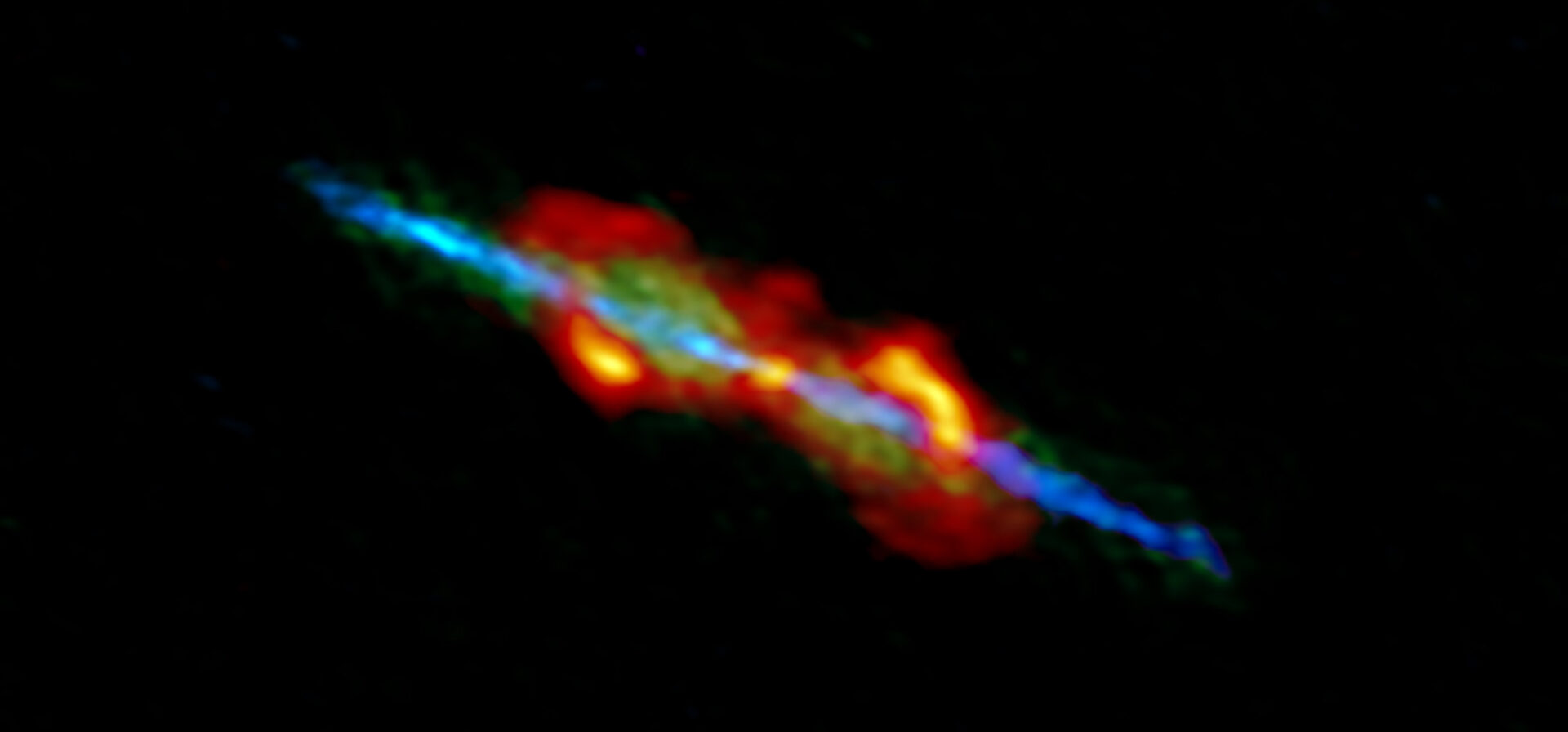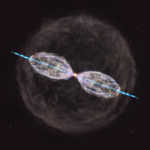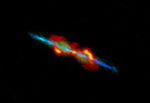ALMA Spots Metamorphosing Aged Star
An international team of astronomers using the Atacama Large Millimeter/submillimeter Array (ALMA) captured the very moment when an old star first starts to alter its environment. The star has ejected high-speed bipolar gas jets which are now colliding with the surrounding material; the age of the observed jet is estimated to be less than 60 years. These are key features to understand how the complex shapes of planetary nebulae are formed.
Sun-like stars evolve to puffed-up Red Giants in the final stage of their lives. Then, the star expels gas to form a remnant called a planetary nebula. There is a wide variety in the shapes of planetary nebulae; some are spherical, but others are bipolar or show complicated structures. Astronomers are interested in the origins of this variety, but the thick dust and gas expelled by an old star obscure the system and make it difficult to investigate the inner-workings of the process.
To tackle this problem, a team of astronomers led by Daniel Tafoya in Chalmers University of Technology, Sweden, pointed ALMA at W43A, an old star system in the constellation Aquila, the Eagle.
Thanks to ALMA’s high resolution, the team obtained a very detailed view of the space around W43A. “The most notable structures are its small bipolar jets,” says Tafoya, the lead author of the research paper published by the Astrophysical Journal Letters. The team found that the velocity of the jets is as high as 175 km per second, which is much higher than previous estimations. Based on this speed and the size of the jets, the team calculated the age of the jets to be less than a human life-span.
“Considering the youth of the jets compared to the overall lifetime of a star, it is safe to say we are witnessing the 'exact moment' that the jets have just started to shove through the surrounding gas,” explains Tafoya. “When the jets carve through the surrounding material in some 60 years, a single person can watch the progress in their life.”
In fact, the ALMA image clearly maps the distribution of dusty clouds entrained by the jets, which is telltale evidence that it is impacting on the surroundings.
The team assumes that this entrainment is the key to form a bipolar-shaped planetary nebula. In their scenario, the aged star originally ejects gas spherically and the core of the star loses its envelope. If the star has a companion, gas from the companion pours onto the core of the dying star, and a portion of this new gas forms the jets. Therefore, whether or not the old star has a companion is an important factor to determine the structure of the resulting planetary nebula.
“W43A is one of the peculiar so called ‘water fountain’ objects,” says Hiroshi Imai at Kagoshima University, Japan, a member of the team. “Some old stars show characteristic radio emissions from water molecules. We suppose that spots of these water emissions indicate the interface region between the jets and the surrounding material. We named them ‘water fountains,’ and it could be a sign that the central source is a binarity system launching a new jet.”
“There are only 15 ‘water fountain’ objects identified to date, despite the fact that more than 100 billion stars are included in our Milky Way Galaxy,” explains José Francisco Gómez at Instituto de Astrofísica de Andalucía, Spain. “This is probably because the lifetime of the jets is quite short, so we are very lucky to see such rare objects.”
Additional Information
These observation results were presented in D. Tafoya et al. “Shaping the envelope of the asymptotic giant branch star W43A with a collimated fast jet” published by the Astrophysical Journal Letters on February 13, 2020.
The research team members are Daniel Tafoya (Calmers University of Technology), Hiroshi Imai (Kagoshima University), José F. Gómez (Instituto de Astrofísica de Andalucía, CSIC), Jun-ichi Nakashima (Sun Yat-sen University), Gabor Orosz (University of Tasmania/Xinjiang Astronomical Observatory), and Bosco H. K. Yung (Nicolaus Copernicus Astronomical Center)
This research was supported by MEXT KAKENHI (No. 16H02167), the Invitation Program for Foreign Researchers of the Japan Society for Promotion of Science (JSPS grant S14128), MINECO (Spain) Grant AYA2017-84390-C2-R (co-funded by FEDER), State Agency for Research of the Spanish MCIU through the “Center of Excellence Severo Ochoa" award for the Instituto de Astrofisica de Andalucía (SEV-2017-0709), Australian Research Council Discovery project DP180101061 of the Australian government, CAS LCWR 2018-XBQNXZ-B-021, and National Key R&D Program 2018YFA0404602 of China.
The original press release was published by the National Astronomical Observatory of Japan (NAOJ), an ALMA partner on behalf of East Asia.
The Atacama Large Millimeter/submillimeter Array (ALMA), an international astronomy facility, is a partnership of the European Organisation for Astronomical Research in the Southern Hemisphere (ESO), the U.S. National Science Foundation (NSF) and the National Institutes of Natural Sciences (NINS) of Japan in cooperation with the Republic of Chile. ALMA is funded by ESO on behalf of its Member States, by NSF in cooperation with the National Research Council of Canada (NRC) and the Ministry of Science and Technology (MOST) and by NINS in cooperation with the Academia Sinica (AS) in Taiwan and the Korea Astronomy and Space Science Institute (KASI).
ALMA construction and operations are led by ESO on behalf of its Member States; by the National Radio Astronomy Observatory (NRAO), managed by Associated Universities, Inc. (AUI), on behalf of North America; and by the National Astronomical Observatory of Japan (NAOJ) on behalf of East Asia. The Joint ALMA Observatory (JAO) provides the unified leadership and management of the construction, commissioning and operation of ALMA.
Images
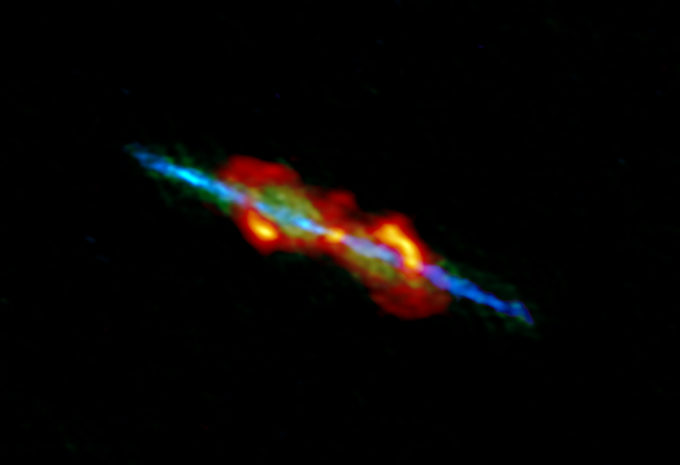
ALMA image of the old star system W43A. The high velocity bipolar jets ejected from the central aged star are seen in blue, low velocity outflow is shown in green, and dusty clouds entrained by the jets are shown in orange.
Credit: ALMA (ESO/NAOJ/NRAO), Tafoya et al.
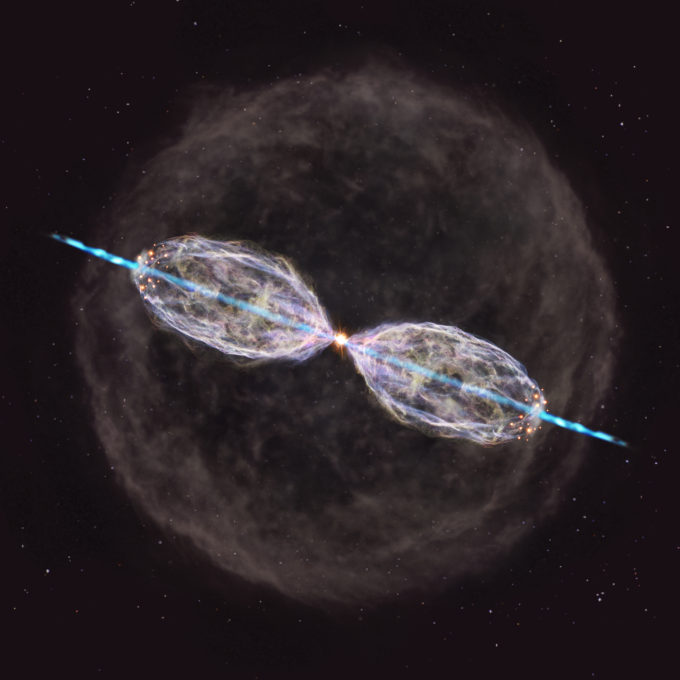
Artist’s impression of W43A based on the ALMA observation results. Diffuse spherical gas was emitted from the star in the past. W43A has just started ejecting bipolar jets which entrain the surrounding material. Bright spots in radio emissions from water molecules are distributed around the interface of the jets and the diffuse gas.
Credit: NAOJ.
Contacts
-
Nicolás Lira
Education and Public Outreach CoordinatorJoint ALMA Observatory, Santiago - ChilePhone: +56 2 2467 6519Cel: +56 9 9445 7726Email: [email protected] -
Masaaki Hiramatsu
Education and Public Outreach Officer, NAOJ Chile -
Bárbara Ferreira
ESO Media Manager -
Iris Nijman
News and Public Information ManagerNational Radio Astronomy Observatory Charlottesville, Virginia - USACel: +1 (434) 249 3423Email: [email protected]
